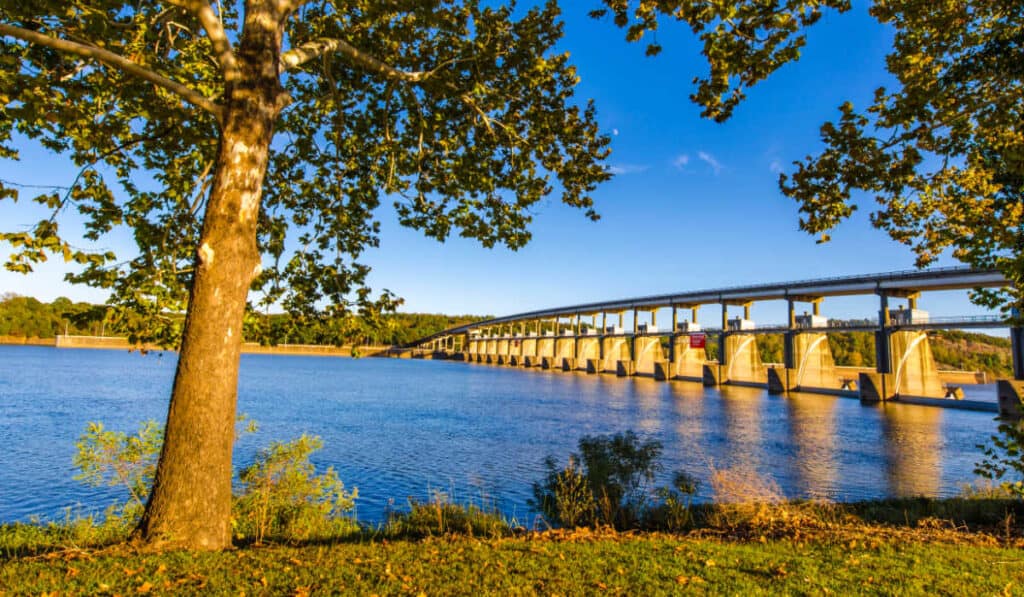Arkansas, known for its natural beauty and diverse landscape, is home to a remarkable variety of trees that grace its forests. The state’s scenery is adorned by flourishing, lush tree canopies that provide a perfect habitat for countless native species. This diverse flora contributes to the unique character of Arkansas and plays a vital role in supporting its ecosystems.
In Arkansas, the largest genera of trees are the oaks, with 31 kinds, including 29 native species. Other prominent tree families include maples, hickories, and plums and cherries, among others. These trees display a vast array of shapes, sizes, and colors, creating a magnificent tableau that transforms with the seasons.
The abundance of tree species in Arkansas offers numerous ecological benefits, such as air purification, soil conservation, and wildlife habitats. As we delve into the world of Arkansas trees, we’ll explore their characteristics, growth, and the role they play in enhancing the state’s natural treasures. Whether you’re a nature enthusiast, a casual observer, or someone interested in learning about Arkansas’ unique flora, this article provides an insightful and fascinating look at the diverse tree species that call this region home.
Trees of Arkansas
Arkansas is home to a diverse variety of trees, with its forests playing a significant role in the state’s ecology and economy. The largest and most common genera of trees in Arkansas include oaks (Quercus), maples (Acer), and hickories (Carya) source. Many of these trees are native to the region, adding to the rich biodiversity of the state.
Oak trees are particularly prevalent, with 29 native species found across the state. These trees are widely recognized for their distinctive leaves and acorns, which provide essential food and habitat for numerous wildlife species. Maples, with nine native species in Arkansas, are admired for their striking fall coloration and versatility in landscaping. Hickories, having ten native species in the state, are known for their hard wood and edible nuts, which are often used in cooking and baking.
In addition to oaks, maples, and hickories, Arkansas is home to several other notable tree species, such as the loblolly pine (Pinus taeda), which is the most commercially valuable tree in the southern United States source. This fast-growing pine species is utilized extensively for timber production and reforestation efforts by the Arkansas Forestry Commission.
The diverse tree species found in the state offer a wide range of ecological benefits, including providing habitat for wildlife, improving air quality, and reducing soil erosion. Many trees in Arkansas also have distinguishing characteristics, such as unique leaves, fruits, or bark. For example, the American holly (Ilex opaca) is recognizable for its glossy, evergreen leaves and bright red berries, while the river birch (Betula nigra) is known for its peeling, reddish-brown bark.
Unfortunately, invasive species like the Callery pear (Pyrus calleryana) and the Chinese tallow tree (Triadica sebifera) have spread throughout the state, posing threats to native flora source. These species can outcompete native plants, leading to negative impacts on ecosystems and the overall health of Arkansas’s forests.
In conclusion, the trees of Arkansas collectively represent a crucial aspect of the state’s ecosystem, contributing to its vibrant natural landscapes and supporting a diverse range of plant and animal life. By appreciating and conserving the native tree species, residents and visitors alike can help protect the unique forest habitats of Arkansas for generations to come.
Native Tree Species
Arkansas is home to a diverse range of native tree species that contribute to the unique landscape and ecology of the state. In this section, we will discuss some of the most common native trees found in Arkansas, including pines, oaks, hickories, magnolias, and birches.
Pines
Pines are a prominent feature of Arkansas forests, with several species native to the state. The Loblolly Pine (Pinus taeda) is the state tree and can be found throughout Arkansas. It is a large, fast-growing tree that prefers well-drained soils. Another common pine species is the Shortleaf Pine (Pinus echinata), also known as the yellow pine. It is indigenous to the Ozark region and grows well in a variety of soil types.
Oaks
Arkansas is home to numerous oak species, with the White Oak (Quercus alba) being a common native tree. White oaks are prized for their strong wood and large stature, reaching heights of up to 100 feet. Their acorns provide an essential food source for many wildlife species.
Hickories
Hickories are another group of native trees found in Arkansas. Of these, the Black Hickory (Carya texana) is a notable example. This medium-sized, slow-growing tree is known for its distinctive, dark gray bark and strong, tough wood. Hickories are often found in mixed hardwood forests, with their nuts serving as an important food source for wildlife.
Magnolias
Arkansas hosts several native magnolia species, which are prized for their large, showy flowers. The Southern Magnolia (Magnolia grandiflora) is an emblematic example of this group of trees. It is an evergreen tree that can reach heights of up to 80 feet, and its fragrant, white blossoms appear in late spring and summer.
Birches
Although less common than some of the previously mentioned species, birches are also native to Arkansas. These deciduous trees are generally found growing in moist areas or near water sources. One example of a native birch is the River Birch (Betula nigra), which is known for its attractive, exfoliating bark and ability to thrive in wet soil conditions.
In summary, Arkansas boasts a rich diversity of native tree species, which contribute to the ecological balance and scenic beauty of the state. From towering pines and stately oaks to fragrant magnolias and graceful birches, these woody plants play a vital role in supporting local wildlife and transforming the landscape with their unique characteristics.
Tree Identification
Arkansas is home to a diverse range of tree species, with some of the most common trees being oaks, maples, hickories, plums, and cherries source. Tree identification is an essential skill for any nature enthusiast, and can be achieved by examining a tree’s bark, leaves, fruit, and flowers. In this section, we will discuss some key features to look for in each of these categories.
Bark
The bark on a tree can provide you with valuable clues to its identity. For instance, Ozark trees such as the shortleaf pine can be identified by their irregularly-shaped, scaly bark which usually appears in red-brown hues source. As you observe tree bark, pay attention to its color, texture, and any distinct patterns or features.
Leaves
Leaves are one of the most easily recognizable parts of a tree and can be quite telling when it comes to identifying the species. A tree’s leaf shape, arrangement, and size are all important factors to consider. For example, oak trees found in Arkansas typically have lobed or toothed leaves, while maple trees have distinct, palmate-shaped leaves source. Look for whether the leaves are simple or compound, and notice their vein patterns and margins.
Fruit
Examining the fruits and seeds of a tree can be a helpful and sometimes necessary tool for accurate identification. Ozark trees such as plums and cherries produce small, round fruits with a single seed inside source. Take note of the fruit’s size, shape, and color, as well as any distinguishing characteristics, like seed pods or cones for trees with needles, such as the shortleaf pine source.
Flowers
Flowers may not always be present on a tree, but when they are, they can be a valuable asset in the identification process. Some common flowers to look for in Arkansas tree species include those of the hawthorn, which produces small white flowers in clusters source. Observe the flower’s color, size, structure, and arrangement on the tree.
When trying to identify a tree, it is helpful to take a photograph of its various features to consult with tree identification guides, databases, or experts for accurate identification source. Remember, it’s essential to remain confident, knowledgeable, neutral, and clear when describing and comparing tree species.
Popular Forested Areas in Arkansas
Arkansas is known for its scenic beauty and abundant forested areas. The state has several popular forested areas that showcase its diverse plant life and tree species. In this section, we’ll explore some of the most popular forests and national parks.
Ozark National Forest
Covering over 1.2 million acres of land in northern Arkansas, the Ozark National Forest is a vast expanse of natural beauty. The region is characterized by its rolling hills, clear streams, and diverse tree species such as short-leaf pine, oak, and hickory. Visitors can enjoy a range of activities like hiking, camping, and fishing while exploring the rich biodiversity of the forest.
Ouachita National Forest
Spreading across 1.8 million acres in western Arkansas and southeastern Oklahoma, the Ouachita National Forest is another renowned woodland area in the state. The forest is home to a variety of trees, including pine, oak, and cedar, and is popular for its breathtaking landscapes and outdoor recreational activities such as mountain biking, horseback riding, and rock climbing.
Buffalo River
The Buffalo River, which meanders through the Ozark Mountains of northern Arkansas, is a popular attraction for nature lovers. As the first national river in the United States, it is protected under federal law and offers visitors pristine waters for canoeing and swimming. The area surrounding the river boasts a rich biodiversity of oak, hickory, and other hardwood trees that provide shade and shelter for various animal species.
Hot Springs National Park
Located near the city of Little Rock in southern Arkansas, Hot Springs National Park is a unique destination known for its therapeutic hot springs. The park, which covers an area of around 5,500 acres, features a mix of woodland and grassy terrain, with oak trees dominating the landscape. Visitors can enjoy scenic walks and hikes amongst the forested areas before relaxing in one of the natural hot springs the park is famous for.
Notable Trees and Shrubs
Dogwoods
One of the most popular and recognizable trees in Arkansas is the Dogwood. These trees thrive in the temperate climates of the state and offer beautiful displays of pink and white flowers in the spring. Not only do Dogwoods add beauty to the landscape, but they also provide habitat and food for wildlife, such as birds and butterflies.
Serviceberries
Serviceberries, also known as Amelanchier arborea, grow naturally throughout Arkansas, providing a burst of white, star-like flowers in the spring. These small, deciduous trees often have multi-stemmed trunks and edible fruit that attract a variety of birds and other wildlife. In the fall, their foliage turns a stunning shade of orange, adding color to the landscape.
Hawthorns
Hawthorns are another group of small flowering trees found in Arkansas. These trees are known for their thorny branches and clusters of small, white or pink flowers. Hawthorns can be found growing in various habitats throughout the state, and provide food and shelter for many wildlife species.
Northern Red Oak
The Northern Red Oak is a large, deciduous tree native to Arkansas. Known for its distinctive lobed leaves and acorn production, Northern Red Oaks play a vital role in the state’s ecosystems. In addition to providing habitat for various wildlife, these trees also contribute to soil health by preventing erosion through their extensive root systems.
Pignut Hickory
Pignut Hickory, a native tree in Arkansas, can be found in many areas within the state. These trees are easily recognizable by their pinnately compound leaves and distinctive, slightly pear-shaped nuts. As the name suggests, the nuts produced by Pignut Hickories are a popular food source for wildlife, including deer, squirrels, and wild hogs.
Threats to Arkansas Trees
Invasive Tree Species
One of the challenges faced by Arkansas trees is the introduction of invasive species that can outcompete native trees and change the ecosystem. The Chinese tallow tree is one example of an invasive tree species found in the state, affecting the balance of native vegetation source. Another invasive species that should be used with caution is the Chinese privet (Ligustrum sinense), a shade-tolerant tree growing to around 30 feet tall source.
Diseases
In addition to invasive species, various diseases can threaten the health and viability of Arkansas trees. While specific diseases were not found within the search results, it’s essential for forest managers to monitor and address these issues to protect the health of the state’s forests.
Pests
Pests are another potential threat to Arkansas trees, causing damage and, in some cases, tree mortality. A recent example is the mysterious problem attacking the loblolly pine, Arkansas’ state tree source. Identifying and addressing such pests is a priority for protecting the long-term health of Arkansas forests.
The Arkansas Department of Agriculture and its partners work towards protecting the forests from these threats, while promoting forest health, stewardship, and conservation for future generations source.
Conservation and Management
The Arkansas Forestry Commission plays a vital role in protecting and managing the forests in Arkansas. Their mission includes protecting Arkansas’s forests from wildland fires and natural hazards, while promoting rural and urban forest health, stewardship, development, and conservation for all generations of Arkansans.
Protected Areas are essential for the conservation and management of Arkansas’s rich biodiversity. These areas serve as sanctuaries for numerous tree species and ecosystems that are vital to the state’s overall environmental health. Some protected areas in Arkansas include Ouachita National Forest, Ozark-St. Francis National Forest, and numerous state parks.
Management strategies adopted by the Arkansas Forestry Commission involve various aspects of forest health, stewardship, and sustainable development. Some of these measures include conservation grants, beaver control programs, and agricultural water quality loan programs. Detailed information on these initiatives can be found on the Conservation section of the Arkansas Department of Agriculture website.
Effective conservation and management ensure the future health and diversity of Arkansas’s trees and forests. Through collaboration with policymakers, organizations, and local communities, the Arkansas Forestry Commission and other agencies adopt numerous strategies to protect and sustainably manage the state’s invaluable natural resources.







